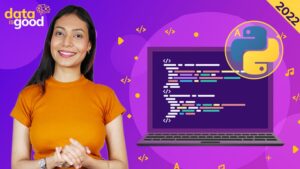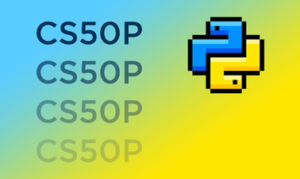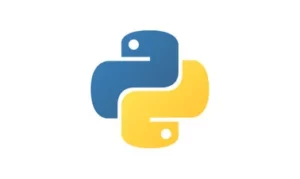Best Python Courses - Q2 2023
Our Expert Picks

Time to Complete:
# Enrolled:
Content Coverage:

Lecturer Quality:

Quiz Quality:

Exercise Quality:

Our Expert Review
Content Coverage (5/5)
This course is structured in 5 modules, comprised of video lectures, readings, coding exercises and quizzes. Course length was very appropriate for a beginner to intermediate learner. All topics that we feel are essential for a Python course are covered, as well as many useful additional topics. Concepts are covered in an easy-to-follow sequence that allows learners to build their knowledge.
Extra topics covered:
- Kwargs
- Exception handing
- Modules
- Machine learning concepts
- Python web frameworks
- Test automation
Lecture Quality (5/5)
The video lectures in this course are short, focused, and high quality. They consist of a presenter introducing a topic, the use of well-designed graphics and animations, and screen sharing as specific coding examples are demonstrated. Lectures also include “pop-up” quiz questions to test the learner’s knowledge of the concepts covered.
Lectures in this course tend to be between 5 and 10 minutes and are separated in logical points to allow the learner many breaks as they learn. The sequence is easy to follow and allows the learner to build concepts as they progress through the course.
Quiz Quality (5/5)
Practice quizzes and end-of-module quizzes are consistently offered throughout the course. Quizzes contain multiple-choice, multiple-select, true/false, and fill-in-the-blank questions.
There are an adequate number of questions in each quiz to test the learner’s knowledge of the material covered in the module.
Learners must receive a minimum score of 80% to earn credit for the quiz. Quizzes are automatically graded upon submission and learners are presented immediate feedback. If the learner answers a question incorrectly, they are provided a link back to the lecture covered by the question.
Learners can retake quizzes up to 3 times every 8 hours.
Assignment/Exercise Quality (5/5)
Coding assignments are provided throughout the course. These assignments are well described and designed. Learners complete most assignments by working directly within a browser-based interactive development environment (IDE). For most assignments “stub code” is provided as hints to the learner. Assignments are submitted and the code is automatically graded.
Certificate Brand Quality (5/5)
This course is provided by Meta through Coursera. Meta is the parent company of Facebook, a well-respected technology company. Coursera is one of the leading learning platforms.

Time to Complete:
# Enrolled:
Content Coverage:

Lecturer Quality:

Quiz Quality:

Exercise Quality:

Our Expert Review
Content Coverage (5/5)
This course is structured in 6 modules, comprised of video lectures, readings, discussion forums, coding labs and quizzes. The course length is appropriate for the material covered. Most of the topics expected for a Python course are covered in this course. The sequence is easy to follow and allows the learner to build concepts as the progress.
Essential Topics Missing:
- File processing
Extras Topics Covered:
- Principles of code reuse
- Coding style
Lecture Quality (5/5)
The lectures in this course are well written and of high production value. Lectures consist of a poised instructor covering the topic, augmented by conceptual graphics, animations, slides, and screenshares of code being written. Lectures are relatively short (3-10 mins) and focused to allow the learner to take breaks as they move through the course.
Quiz Quality (5/5)
Quizzes are consistently offered at the end of each lesson within each module. Quizzes contain multiple-choice, and a kind of fill-in-the-blank question that allows the learner to write and execute python code. Each lesson has roughly 5 questions, which we found to be adequate to test the learner’s knowledge of the material covered in lesson.
Learners must receive a minimum score of 80% to earn credit for the quiz. Quizzes are automatically graded upon submission and learners are presented immediate feedback. If the learner answers a question incorrectly, they are provided with helpful hints. Learners are able to retake quizzes as many times as necessary.
Assignment/Exercise Quality (4/5)
Many, but not all, of the modules include “labs” that allow learners to try guided exercises in a web-based interactive development environment (IDE). The labs are well designed and do allow the learner to practice and apply what they’ve learned. However, no instructor feedback is provided.
Certificate Brand Quality (5/5)
This course is provided by Google through Coursera. Google is one of the most respected technology companies in the world and Coursera is one of the leading learning platforms.

Time to Complete:
# Enrolled:
Content Coverage:

Lecturer Quality:

Quiz Quality:

Exercise Quality:

Our Expert Review
Content Coverage (5/5)
This is a nicely structured class on python programming. The course is comprised of video lectures, code examples, discussion forums, coding exercises, and timely quizzes. The course covers all topics we consider to be essential in a Python course, as well as a few extras. Most of the topics were covered in a sequence that allows learners to build their knowledge.
Extra Topics Covered
- Frozenets
- Regular Expressions
Lecture Quality (5/5)
The instructor for this course – Mihai Catalin Teodosiu – is really a strong python enthusiast and has very impressive credentials. He holds a B.Sc. degree in Telecommunication and Information Technology from University of Polytechnical of Bucharest, Romania. He also holds several professional certifications such as CCNP, CCNA, CCDA, JNCIA and ISTQB CTFL. His work experience spans Networking and Quality Assurance Engineering using python vastly in Network Automation and Test Automation. He has been teaching with Epic Python, Udemy, and other e-learning platforms since 2015. He had over 100,000+ students from over 170 countries. He teaches smoothly and nicely, explaining in the most empirical/foundational way.
Most of the video lectures are simple screenshares as the instructor codes within an IDE. The code examples are well thought out and the instructor provides clear voice-over that walks through each example.
We found that some sections, such as strings and string manipulation, are not as thoroughly covered as we feel they could have been. Overall, the duration of the videos in this course seems appropriate.
Quiz Quality (5/5)
Quizzes are consistently offered at the end of each module in this course. The number of questions for some quizzes are not always sufficient to test the learner’s knowledge of the material covered. However, most sections also included Coding Exercises. Between quizzes and coding exercises, there are more than enough opportunities for the learner to assess their knowledge.
The quizzes are automatically graded and learners are presented with helpful feedback upon submissions. Quizzes can be taken as many times as necessary to earn full credit.
Assignment/Exercise Quality (5/5)
This course provides regular coding exercises for which the learner can use a simple IDE embedded within the browser. Each exercise contains adequate instructions, and the IDE provides immediate feedback. Learners can attempt the exercises multiple times. A full code solution is provided for all exercises.
Certificate Brand Quality (3/5)
The course is offered by Mihai Catalin Teodosiu through Udemy. While the instructor is well qualified, he is not well known within Computer Science. Udemy is a leading platform, but content quality varies widely within their courses.

Time to Complete:
# Enrolled:
Content Coverage:

Lecturer Quality:

Quiz Quality:

Exercise Quality:

Our Expert Review
Content Coverage (5/5)
This course is structured in 19 modules, comprised of video lectures, coding assignments, and quizzes. The course is extremely thorough, covering most of the topics we consider to be essential for a Python course as well as many additional concepts. The sequence is easy to follow and allows learners to build their knowledge as they progress.
Essential Topics Missing:
- File processing
Extras Topics Covered:
- Stacks and Queues
- Searching
- Sorting
- Recursion
- Dates and Times
- Regular expressions
- Numby
- Pandas
Lecture Quality (4/5)
The presenter for this course is poised and easy to understand. The lectures consist of the presenter speaking to the learner in one part of the screen while code examples or conceptual graphics and animation show in another part. Each lecture is very well written and designed. However, the presenter does not seem to be an expert in Python herself, and sometimes reads the scripts in a way that a programmer might not.
Quiz Quality (5/5)
Quizzes are consistently offered within most modules of this course. Quizzes contain multiple-choice questions that often require the learner to evaluate actual python code. There were more than enough questions in each quiz to test the learner’s knowledge of the material covered in the module.
Learners must answer all questions correctly to earn credit for the quiz. Each question is automatically graded upon submission and learners are presented with immediate correct/incorrect feedback. Learners can answer the question as many times as necessary.
Finally, each quiz has a lecture following it that explains each answer to the learner.
Assignment/Exercise Quality (4/5)
There are exercises with downloadable resources in each of the modules. The exercises require learners to solve a real-world scenario using prescriptive coding practices. Each exercise also has a solution that students can watch after attempting the exercises.
The exercises are not submitted and no feedback is provided by an instructor.
Certificate Brand Quality (4/5)
This course is provided by Data is Good through Udemy. While not widely known, Data is Good is professional technical education company with verifiable credentials.

Time to Complete:
# Enrolled:
Content Coverage:

Lecturer Quality:

Quiz Quality:

Exercise Quality:

Our Expert Review
Content Coverage (5/5)
This course is structured in 11 modules, consisting of recorded video of lectures, readings, notes, slides, source code, discussion forums, and assignments (problem sets). The course is taught in a sequence that is easy for learners to follow, building concepts as they go.
The majority of topics expected for a typical python course are covered in this course, as well as some extras that can be very helpful in professional coding.
Essential topics missing:
- Lambda functions
- Tuples
- Sets
Extra topics covered:
- Handling exceptions
- Debugging
- Using visual studio
- Unit testing
- Regular expressions
Lecture Quality (5/5)
The lecturer for this course – David J Malan – is a Harvard professor as well as a Professor in Residence at GitHub. The video lectures consist of the instructor lecturing directly to class while writing specific code. The code used in each lecture is well planned and often scaffolds to present new ideas. Most lectures also include frequently asked questions from students that the instructor answers. The instructor also covers some complicated concepts a bit fast for some beginning learners.
Lectures can be skipped forward, which can be useful, but does allow learners to skip specific parts of the lectures.
Each lecture includes full notes with code examples and graphics. This is an excellent resource.
Quiz Quality (1/5)
There are no quizzes offered with this course. However, there are sample coding exercises.
Assignment/Exercise Quality (5/5)
The assessments are mostly problem sets containing practical coding questions. Each module of the course has a problem set that allows learners to practice and apply the concepts in the module.
Learners must attempt each problem set and submit to a cloud platform, where they are graded either automatically or by Harvard staff.
There is also a final coding project, which allows learners to conceive of and build their own project. Learners must record a video explaining their project, a readme file with full explanation of the code, and code, which is submitted to GitHub for review by Harvard staff.
Certificate Brand Quality (5/5)
This course is provided by Harvard University through edx.org. Harvard University is one of the most well-known and respected universities in the world and EdX is one of the leading learning platforms.

Time to Complete:
# Enrolled:
Content Coverage:

Lecturer Quality:

Quiz Quality:

Exercise Quality:

Our Expert Review
Content Coverage (4.5/5)
This course is structured in 5 modules, consisting of video lectures, readings, discussion forums, assignments, and quizzes. All topics expected for an applied python course are covered in this course. However, we did not feel that enough time and coverage was provided on some of the more complex topics.
Extra topics covered:
- Exception handling
- Loading and working with data using Panda
- Working with APIs
Lecture Quality (4/5)
The lectures for this course consist of animated visuals accompanied by voice over. In most cases, the visuals are very useful. However, since there is no person on screen, the course lacks a personable feel. We felt that several of the lectures on complex topics were presented too quickly and without enough coverage.
Quiz Quality (3/5)
Both practice and graded quizzes are consistently offered within each module in this course. Quizzes tend to be short, with 3-5 multiple-choice questions. Many of the quiz questions only have two answer options. We did not feel that the number of questions nor the answer options were sufficient to test the students on all the concepts covered.
Quizzes are automatically graded, and helpful feedback is provided when students answer questions incorrectly. Learners are able to retake quizzes up to 2 times.
Assignment/Exercise Quality (3.5/5)
In-depth hands-on assignments are provided with each module. The assignments are presented within a browser-based development environment. They have review material and interactive and prescriptive ways for learners to experiment with code. The assignments are not submitted for grading or feedback, however.
Certificate Brand Quality (5/5)
This course is provided by an IBM Developer through edx.org. IBM is one of the most well-known and respected technology companies in the world and edX is one of the leading learning platforms.
What to Look For in a Python Course
Our experts consider the following topics to be essential in a Customer Service Course.
-
Python Installation
-
Data types, variables, typecasting, and comments
-
Basic Operators and Input-Output Operations
-
Boolean Expressions and Conditionals
-
Logical and Bitwise Operations
-
Repetition (looping)
-
List and List processing
-
Writing functions
-
Tuples, Set and Dictionaries
-
Strings and String manipulation
-
File processing
-
Lambda functions and Math Libraries
-
Object-Oriented Programming
-
Classes, Objects, and Methods, Constructors
-
Inheritance, Encapsulation and Polymorphism
High Growth Jobs That Require Python Skills
Click any of the links below to view the salary, job growth, necessary skills, and other information related to these jobs:
The Major Online Learning Platforms
Each online learning platform is unique. Some specialize in certain types of content, some partner with major universities or corporations to develop content, and some have special learning features. While not exhaustive, the list below includes the major online platforms whose courses we feature.
Pros / Cons
Pros: Certificates often are offered from major universities or corporations.
Cons: The quality of course content and features available varies dramatically between courses.
Cost
$$$
Pros / Cons
Pros: Courses are very similar to those offered in colleges.
Cons: The quality of content and features offered varies dramatically between learning programs.
Cost
$$$$
Pros / Cons
Pros: A focus on microlearning with consistently high-quality content. Consistent use of quizzes throughout all courses.
Cons: Pricing is skewed toward annual subscriptions, which is far more content (and cost) than most learners need within a year.
Cost
$$$
Pros / Cons
Pros: Labs offer a means of gaining practical experience in technical skills.
Cons: There are no incremental quizzes or ways to test learners on specific topics.
Cost
$$$$
Pros / Cons
Pros: Udemy tends to be one of the more affordable options for individuals looking to learn specific technical skills.
Cons: Highly inconsistent quality between courses.
Cost
$
Pros / Cons
Pros: Consistent, high-quality micro-content that focuses on practical exercises.
Cons: The catalog is somewhat limited compared to other vendors on this list.
Cost
$$$
Pros / Cons
Pros: Many free online classes are offered. Live online classroom experiences are offered for some of their courses.
Cons: Variable quality of courses, with some courses having relatively low quality.
Cost
$$$$$
Pros / Cons
Pros: Skillshare has a large library of courses related to creative skills.
Cons: Most courses are just a series of lectures with no interactivity, quizzing, or opportunities to practice concepts.
Cost
$$$
For more information, check out our detailed post on the best online course platforms.
Frequently Asked Questions about Customer Service
Are Python Skills in Demand?
Yes. According to LinkedIn Learning’s 2023 analysis, Python ranks fourth among the most in-demand skills by employers. Python is also the fourth most popular programming, scripting, and markup language according to Stack Overflow’s 2022 developer survey.
Why is Python so popular?
Python is a popular programming language for several reasons:
- Ease of Learning: Python has a simple and easy-to-understand syntax that makes it easy for beginners to learn. Its readability and simplicity make it a great choice for new programmers.
- Versatility: Python is a general-purpose language that can be used in various fields, such as data science, web development, machine learning, artificial intelligence, scientific computing, and more. Its versatility makes it a popular choice among developers.
- Large Community: Python has a large and active community of developers who contribute to the language’s growth and development. This community offers support, resources, and tools to Python users, making it easier for beginners to get started.
- Libraries and Frameworks: Python has an extensive collection of libraries and frameworks, making it easier for developers to work with complex data structures, implement machine learning algorithms, build web applications, and more.
- Portability: Python code can be run on various platforms, including Windows, Linux, and Mac OS. This makes it easy for developers to write code on one platform and run it on another without any compatibility issues.
- Open-Source: Python is an open-source language, meaning it is free to use, modify, and distribute. This allows developers to create and share software without any licensing fees or restrictions, making it an attractive option for small businesses and startups.
How much to Python developers earn?
Python developer salaries typically range from from $74,000 to $180,000 with a median of about $118,000.
Why is Python used for machine learning?
Python has a vast collection of libraries and frameworks that make it easier for developers to work with machine learning tasks. A programming library is essentially a series of pre-build functions for common tasks that can be incorporated into new programs. Popular libraries such as NumPy, Pandas, TensorFlow, and Scikit-learn provide tools and resources to handle data manipulation, statistical analysis, and machine learning algorithms.





